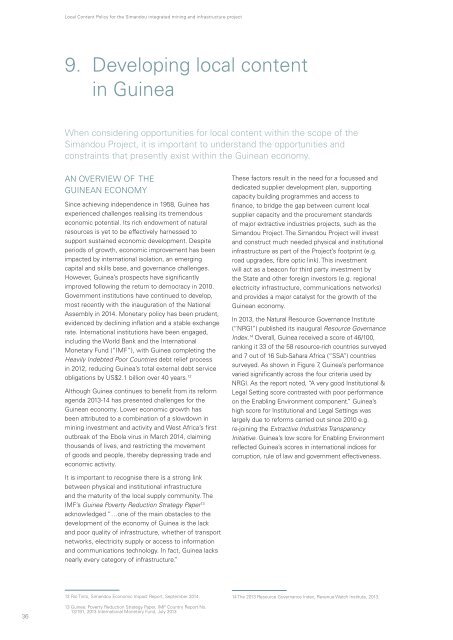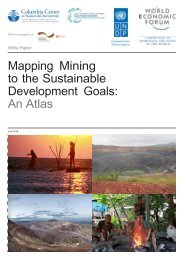20Nwews
20Nwews
20Nwews
Create successful ePaper yourself
Turn your PDF publications into a flip-book with our unique Google optimized e-Paper software.
Local Content Policy for the Simandou integrated mining and infrastructure project<br />
9. Developing local content<br />
in Guinea<br />
When considering opportunities for local content within the scope of the<br />
Simandou Project, it is important to understand the opportunities and<br />
constraints that presently exist within the Guinean economy.<br />
AN OVERVIEW OF THE<br />
GUINEAN ECONOMY<br />
Since achieving independence in 1958, Guinea has<br />
experienced challenges realising its tremendous<br />
economic potential. Its rich endowment of natural<br />
resources is yet to be effectively harnessed to<br />
support sustained economic development. Despite<br />
periods of growth, economic improvement has been<br />
impacted by international isolation, an emerging<br />
capital and skills base, and governance challenges.<br />
However, Guinea’s prospects have significantly<br />
improved following the return to democracy in 2010.<br />
Government institutions have continued to develop,<br />
most recently with the inauguration of the National<br />
Assembly in 2014. Monetary policy has been prudent,<br />
evidenced by declining inflation and a stable exchange<br />
rate. International institutions have been engaged,<br />
including the World Bank and the International<br />
Monetary Fund (“IMF”), with Guinea completing the<br />
Heavily Indebted Poor Countries debt relief process<br />
in 2012, reducing Guinea’s total external debt service<br />
obligations by US$2.1 billion over 40 years. 12<br />
Although Guinea continues to benefit from its reform<br />
agenda 2013-14 has presented challenges for the<br />
Guinean economy. Lower economic growth has<br />
been attributed to a combination of a slowdown in<br />
mining investment and activity and West Africa’s first<br />
outbreak of the Ebola virus in March 2014, claiming<br />
thousands of lives, and restricting the movement<br />
of goods and people, thereby depressing trade and<br />
economic activity.<br />
These factors result in the need for a focussed and<br />
dedicated supplier development plan, supporting<br />
capacity building programmes and access to<br />
finance, to bridge the gap between current local<br />
supplier capacity and the procurement standards<br />
of major extractive industries projects, such as the<br />
Simandou Project. The Simandou Project will invest<br />
and construct much needed physical and institutional<br />
infrastructure as part of the Project’s footprint (e.g.<br />
road upgrades, fibre optic link). This investment<br />
will act as a beacon for third party investment by<br />
the State and other foreign investors (e.g. regional<br />
electricity infrastructure, communications networks)<br />
and provides a major catalyst for the growth of the<br />
Guinean economy.<br />
In 2013, the Natural Resource Governance Institute<br />
(“NRGI”) published its inaugural Resource Governance<br />
Index. 14 Overall, Guinea received a score of 46/100,<br />
ranking it 33 of the 58 resource-rich countries surveyed<br />
and 7 out of 16 Sub-Sahara Africa (“SSA”) countries<br />
surveyed. As shown in Figure 7, Guinea’s performance<br />
varied significantly across the four criteria used by<br />
NRGI. As the report noted, “A very good Institutional &<br />
Legal Setting score contrasted with poor performance<br />
on the Enabling Environment component.” Guinea’s<br />
high score for Institutional and Legal Settings was<br />
largely due to reforms carried out since 2010 e.g.<br />
re-joining the Extractive Industries Transparency<br />
Initiative. Guinea’s low score for Enabling Environment<br />
reflected Guinea’s scores in international indices for<br />
corruption, rule of law and government effectiveness.<br />
It is important to recognise there is a strong link<br />
between physical and institutional infrastructure<br />
and the maturity of the local supply community. The<br />
IMF’s Guinea Poverty Reduction Strategy Paper 13<br />
acknowledged “…one of the main obstacles to the<br />
development of the economy of Guinea is the lack<br />
and poor quality of infrastructure, whether of transport<br />
networks, electricity supply or access to information<br />
and communications technology. In fact, Guinea lacks<br />
nearly every category of infrastructure.”<br />
12 Rio Tinto, Simandou Economic Impact Report, September 2014.<br />
14 The 2013 Resource Governance Index, Revenue Watch Institute, 2013.<br />
36<br />
13 Guinea: Poverty Reduction Strategy Paper, IMF Country Report No.<br />
13/191, 2013 International Monetary Fund, July 2013






